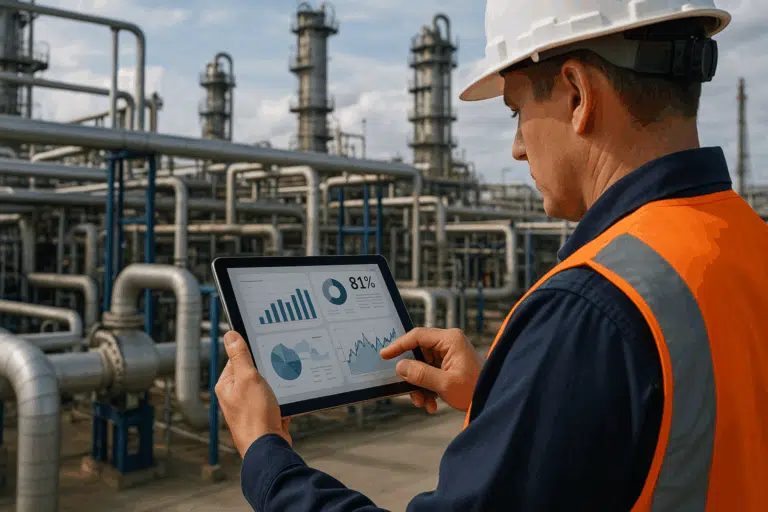What are oil and gas operations really about? In essence, they involve the complex coordination of assets, infrastructure, and people to extract, transport, refine, and deliver energy efficiently and safely. But as the sector becomes more data-driven and cost-sensitive, a critical transformation is underway: integrating asset tracking technologies with Plant Maintenance and Asset Accounting modules.
This integration exists because traditional methods—based on spreadsheets, siloed systems, and time-based maintenance—can no longer sustain the scale and precision that oil and gas operations require. Companies struggle with asset visibility, unexpected equipment failures, and inaccurate financial reporting, which not only inflate costs but also expose them to compliance risks.
By aligning operational data with financial and maintenance systems, companies unlock a strategic advantage: full control over asset performance, lifecycle costs, and regulatory readiness. In this article, we’ll show how oil and gas operations are evolving through this integration—leveraging technologies like RFID, IoT, and predictive analytics to transform field data into actionable insights. And although subtle for now, this shift connects directly to the strategic expertise and solutions offered by CPCON.
Table of Contents
ToggleWhat You’ll Learn from This Article
- What oil and gas operations really involve—and why integration is now essential
- How asset tracking technologies like RFID, IoT, and AI are transforming the sector
- The strategic benefits of integrating with Plant Maintenance and Asset Accounting modules
- Real-world impact of integration on downtime, maintenance costs, and ROI
- How CPCON supports oil and gas companies with end-to-end digital solutions
- What key steps are required for a successful implementation
- Why integration is the foundation for future-ready, compliant, and cost-effective operations
What Are Oil and Gas Operations and Why Integration Matters
Oil and gas operations encompass all the complex activities required to explore, extract, process, and distribute petroleum products. These operations involve high-value assets, strict regulatory requirements, and a continuous push for efficiency. Every pipeline, valve, and compressor plays a critical role—and any misstep can lead to costly downtime or compliance violations.
Traditionally, operational and financial systems in oil and gas were managed separately. Maintenance teams worked in one system, finance in another, and asset tracking—if it existed—was often manual and reactive. This separation created blind spots. Equipment would fail unexpectedly, records would mismatch, and costs would escalate without clear visibility into why.
Integration changes everything. By connecting asset tracking technologies directly to Plant Maintenance and Asset Accounting systems, companies gain a unified view of their operations. For example, when a sensor detects equipment degradation in real time, the system can automatically trigger a maintenance order and update the financial depreciation schedule. This creates a loop of operational intelligence that wasn’t possible before.
Imagine a scenario where a refinery’s heat exchanger begins to operate outside of optimal temperature range. In an integrated setup, IoT sensors detect the anomaly instantly, the PM module schedules a condition-based intervention, and the AA module adjusts asset valuation based on projected wear. All of this happens without spreadsheets, without silos, and without delays.
This is why integration is no longer optional. For oil and gas operations to be agile, safe, and financially accurate, digital connection between systems is the foundation. It’s the first step to a smarter, more resilient operation.

How Asset Tracking Technology Has Evolved in Oil and Gas Operations
For years, asset management in oil and gas relied on clipboards, spreadsheets, and reactive maintenance. While this approach may have worked in simpler times, it no longer supports the scale, complexity, and speed demanded by today’s operations. The industry needed a smarter way to monitor and manage high-value equipment spread across vast, often remote environments.
That’s where modern asset tracking technologies emerged—and they’ve changed everything.
Let’s break down the most impactful advancements:
- IoT Sensors and Real-Time Monitoring
These sensors collect live data on pressure, vibration, temperature, and other key indicators. Instead of waiting for failure, companies now know exactly when equipment begins to deviate from optimal performance. - RFID and GPS Tracking
Items like drilling tools, safety gear, and mobile pumps can now be located instantly, even on offshore platforms or across wide oil fields. No more wasted time looking for lost assets. - Digital Twin Technology
Think of a digital twin as a virtual replica of your physical asset. It lets engineers simulate conditions, test performance scenarios, and plan interventions—all without touching the real equipment. - AI and Machine Learning
Algorithms analyze vast volumes of sensor data to detect patterns and predict failures before they happen. This allows maintenance teams to act before problems escalate.
Each of these technologies brings value on its own. But when they’re integrated into maintenance and accounting systems, they form a complete digital ecosystem. One that’s proactive, connected, and optimized for both uptime and financial clarity.
In practical terms, this means no more surprise failures, no more gaps between field data and balance sheets, and no more inefficiencies hiding in the shadows. Just real-time visibility, automated insights, and smarter decision-making.
The Power of Integration with Plant Maintenance Modules
Plant Maintenance (PM) modules are the operational backbone of any maintenance strategy in oil and gas operations. They coordinate inspections, schedule repairs, manage spare parts, and document service histories. But when used in isolation, these modules only respond to problems after they’ve occurred. That’s where integration with asset tracking technologies changes the game.
Imagine having a compressor on a drilling site that vibrates beyond safe thresholds. In a traditional setup, the issue might go unnoticed until the next scheduled check. But with real-time tracking integrated into the PM module, the system automatically logs the anomaly, triggers a work order, and assigns a technician with the right tools—all within minutes.
This is the power of condition-based and predictive maintenance working together.
Here’s what this integration unlocks:
- Condition-Based Maintenance (CBM)
Maintenance activities are triggered by real-time asset health instead of time intervals. This reduces unnecessary inspections, minimizes downtime, and extends equipment lifespan. - Predictive Failure Analysis
AI-powered algorithms analyze trends and sensor patterns to forecast failures before they happen. You don’t just react—you prepare. - Smarter Resource Allocation
Maintenance crews, parts, and schedules are automatically optimized based on asset priority, risk level, and operational impact. - Complete Maintenance History
Every inspection, repair, and sensor alert is recorded in one place. This creates a full audit trail for regulatory compliance and future planning.
In the oil and gas sector, downtime is costly and dangerous. By integrating asset tracking into your Plant Maintenance system, you create a maintenance ecosystem that is proactive, precise, and deeply informed by real-time data.
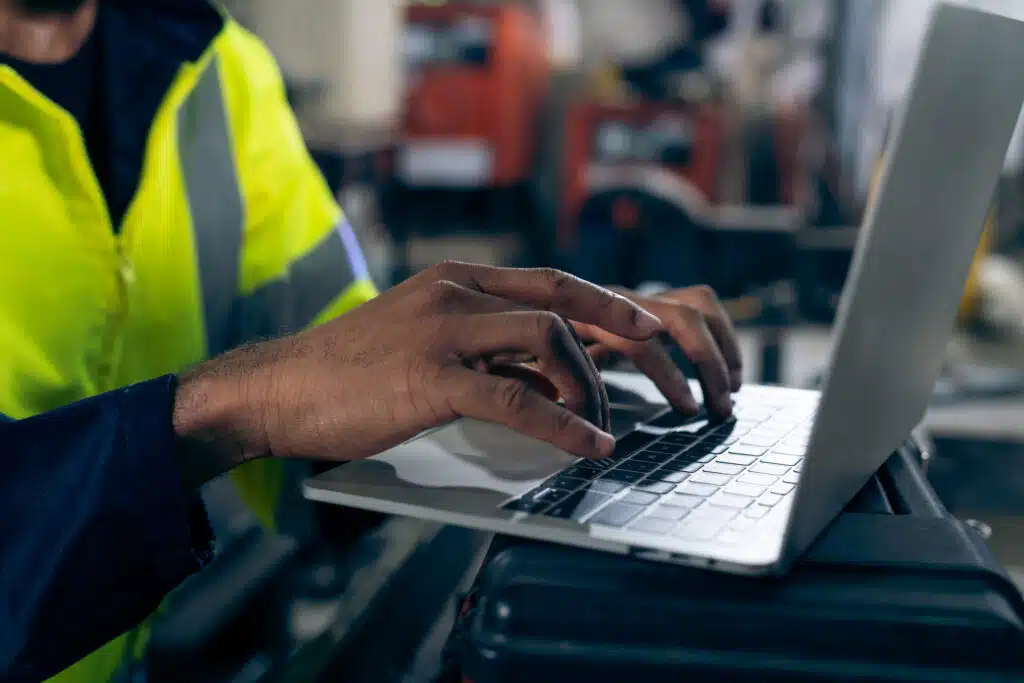
Connecting Asset Tracking to Asset Accounting: Financial Accuracy in Action
While Plant Maintenance focuses on equipment performance, Asset Accounting (AA) governs the financial lifecycle of each asset. The challenge? These two systems rarely “talk” to each other. As a result, what’s happening in the field often doesn’t match what’s recorded in the books.
By integrating asset tracking data with Asset Accounting modules, oil and gas companies create a single version of truth—both operationally and financially.
Let’s look at the difference this makes:
- More Accurate Asset Valuation
Traditional accounting relies on straight-line depreciation formulas. But with real-time usage and condition data, depreciation can be calculated based on actual performance. That means fewer surprises in audits—and more reliable balance sheets. - Automated Compliance Reporting
With every maintenance event and status change logged automatically, financial teams have access to a detailed, auditable history. This simplifies reporting and reduces the risk of non-compliance with regulatory standards like IFRS or US GAAP. - Total Cost of Ownership (TCO) Visibility
Integration reveals the true cost of each asset—from purchase and maintenance to downtime and disposal. CFOs gain a clearer picture of ROI and can optimize asset replacement strategies. - Better Investment Planning
When finance teams see how assets are performing in real time, they can make smarter decisions about capital expenditures. It’s no longer about guessing—it’s about acting on evidence.
Consider this: a generator operating under extreme load in a remote site has a much shorter useful life than expected. If the accounting system isn’t aware of this, depreciation remains misaligned. But with integration, finance is alerted as soon as the asset’s condition drops, and forecasts are automatically adjusted.
In oil and gas operations, where asset portfolios reach billions of dollars, this level of accuracy is not a luxury—it’s a necessity.
Real-World Results: A Case Study from Offshore Oil and Gas Operations
To understand the real impact of integrating asset tracking with maintenance and accounting systems, let’s look at a mid-sized offshore drilling operation facing high operational risks and frequent equipment failures.
This operation, part of Petrobras’ offshore portfolio, managed hundreds of critical assets under extreme marine conditions. The challenge: frequent unplanned downtime of key equipment, resulting in production losses and high operational costs.
The company implemented a comprehensive solution: RFID tagging and real-time monitoring of critical assets—pumps, compressors, generators—connected directly to their Plant Maintenance and Asset Accounting modules within the ERP.
As a result:
- Substantial reduction in unplanned downtime
- Significant decrease in maintenance costs
- Notable improvement in asset utilization
- Optimized spare parts inventory management
- Positive ROI achieved within the first year of implementation
This transformation wasn’t just about adding sensors. It was about connecting field data to financial and operational decisions in real time. The result: more efficiency, more control, and a smarter way to manage oil and gas operations.
Explore More Strategic Insights
Want to dive deeper into asset management, auditing, and RFID solutions? Here are some recommended articles to expand your knowledge:
- GAAP vs IFRS: Key Differences That Impact Your Asset Management
- Fixed Asset Audit: Checklist with 5 Practical Steps to Prepare Yourself
- RFID Inventory Management: Learn How to Reduce Costs and Improve Operational Performance
Key Factors for a Successful Integration Journey
Implementing a fully integrated asset ecosystem in oil and gas operations isn’t just about choosing the right technologies—it’s about executing a transformation. And like any transformation, success depends on strategy, people, and discipline.
Based on industry benchmarks and CPCON’s experience with global clients, here are the pillars that ensure a smooth and effective integration:
- Change Management
Integration disrupts long-standing processes. Success requires early engagement with key stakeholders—maintenance, finance, IT, and operations. Training, communication, and hands-on support help build confidence and accelerate adoption. - Data Governance
Real-time tracking only works if the data is clean, consistent, and trustworthy. That means setting clear ownership for asset information, creating standard protocols for data entry, and auditing for integrity. - ERP Compatibility and Interoperability
The new technologies must plug seamlessly into existing systems like SAP, Oracle, or Totvs. Investing in middleware or APIs ensures smooth data flow between sensors, maintenance modules, and accounting platforms. - Cybersecurity by Design
Oil and gas infrastructure is a target for cyber threats. Protecting real-time asset data requires encryption, access control, and continuous monitoring—especially when integrating cloud-based tools. - Scalability and Flexibility
A successful pilot is just the beginning. Integration frameworks should be scalable across multiple facilities, adaptable to new assets, and ready to evolve as operations grow.
Companies that treat integration as a one-time IT project often struggle. But those that view it as an ongoing capability—backed by process, people, and governance—build long-term resilience.
Integration is not just about technology adoption. It’s about operational alignment. When done right, it creates a platform for smarter decisions, lower costs, and stronger compliance—company-wide.
How CPCON Helps You Build Smarter Oil and Gas Operations
At CPCON, we know that managing oil and gas operations means managing complexity. From offshore platforms to refineries, companies are under pressure to reduce downtime, ensure compliance, and maintain full control over high-value assets. That’s why we don’t just offer technology—we deliver integrated solutions that combine asset tracking, maintenance intelligence, and financial accuracy.
Our team works side by side with operational, maintenance, and financial leaders to design and implement end-to-end strategies tailored to each environment. Whether you’re running SAP, Oracle, or another ERP system, our RFID and IoT-based solutions connect directly to Plant Maintenance and Asset Accounting modules—ensuring that field data flows seamlessly across the enterprise.
Here’s how CPCON delivers value in oil and gas operations:
- Customized RFID Tagging Solutions
We map and tag critical equipment across the operation, ensuring traceability, even in harsh offshore or remote environments. - Full Integration with ERP Systems
Our team implements and tests the connection between sensors, field systems, and core business modules—minimizing disruptions and maximizing ROI. - Predictive Maintenance Enablement
We enable real-time data capture and AI-driven analytics, helping teams act before failures happen. - Financial and Compliance Readiness
Our integrated systems automatically generate asset documentation, support audit trails, and ensure alignment with accounting and regulatory standards. - Ongoing Support and Scalability
CPCON doesn’t stop at implementation. We support continuous improvement, system scalability, and operational excellence over time.
In short, we help oil and gas companies move from reactive control to proactive command. With CPCON, every asset is accounted for, every maintenance decision is data-driven, and every investment is backed by real performance metrics.
Looking Ahead: Why Integration Is the Future of Oil and Gas Operations
The oil and gas industry is facing a crossroads. With increasing regulatory pressure, tighter margins, and rising expectations for safety and sustainability, operational excellence is no longer optional—it’s urgent. And integration is proving to be the foundation that supports this next chapter.
By aligning asset tracking, maintenance operations, and financial systems, companies unlock real-time visibility, smarter decision-making, and long-term cost efficiency. But the benefits go beyond internal gains.
Here’s what integration enables moving forward:
- Faster Response to Market Volatility
When systems are connected, companies can adjust operations quickly based on demand shifts, supply chain disruptions, or geopolitical changes. - Smarter Capital Allocation
Decision-makers get full visibility into asset performance and cost of ownership—leading to more strategic investments. - Stronger ESG and Compliance Capabilities
Integrated documentation and real-time reporting support audit readiness and environmental accountability. - Reduced Environmental Impact
Predictive maintenance and optimized resource use result in fewer failures, less waste, and more sustainable operations. - Greater Resilience Through Data
When disruption strikes, companies with integrated systems recover faster—because they already know what’s happening and where to act.
Integration isn’t just a trend. It’s a transformation that future-proofs oil and gas operations. And for organizations ready to evolve, it opens the door to more control, more efficiency, and more strategic impact across the value chain.
Strategic Control Starts with Integration
The path to smarter oil and gas operations is not paved by isolated tools or one-off improvements. It’s built on integration—where asset tracking, maintenance, and accounting systems work together to deliver clarity, control, and continuous improvement.
Organizations that embrace this connected approach don’t just fix problems faster. They anticipate them. They don’t just meet compliance—they prove it with real-time data. And they don’t just reduce costs—they understand exactly where their investments generate value.
Investing in this integration is not a short-term fix—it’s a long-term strategy that gives oil and gas companies a decisive edge in efficiency, resilience, and governance.
Ready to gain full control over your oil and gas operations?
Contact CPCON today and discover how integration can turn your operations into a smarter, safer, and more profitable environment.
FAQ
What are oil and gas operations?
Oil and gas operations include all the processes involved in exploring, extracting, refining, and distributing petroleum products. These operations rely heavily on the performance and availability of physical assets, maintenance routines, and accurate financial reporting.
How does asset tracking improve oil and gas operations?
Asset tracking technologies like RFID, IoT, and GPS provide real-time visibility into asset location, condition, and usage. This helps oil and gas companies reduce downtime, improve maintenance planning, and increase operational efficiency.
Why integrate asset tracking with Plant Maintenance systems?
Integration enables condition-based and predictive maintenance. It ensures maintenance tasks are triggered by real-time data, not fixed schedules, resulting in fewer failures, longer asset lifespans, and lower maintenance costs.
What are the financial benefits of integrating tracking with Asset Accounting?
When tracking is connected to accounting systems, depreciation becomes more accurate, compliance reporting is simplified, and companies gain full visibility into total cost of ownership for each asset.
How can CPCON help optimize oil and gas operations?
CPCON offers complete integration of asset tracking with Plant Maintenance and Asset Accounting modules. With advanced technologies and strategic consulting, CPCON helps companies gain control, reduce risks, and scale performance across operations.

